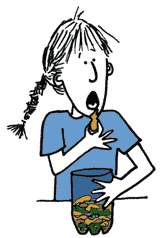|
 Like
many good things in life, the inspiration for Bottle Biology
arose unexpectedly — in this case from a pile of autumn leaves.
While raking his garden, Paul Williams, a professor of Plant Pathology
at the University of Wisconsin-Madison, asked himself what might
be going on in the middle of the large compost pile he was creating.
Why not put some of the leaves in an empty soda bottle and watch
them to find out, he wondered. The result: The
Decomposition Column and the beginning of Bottle Biology. Like
many good things in life, the inspiration for Bottle Biology
arose unexpectedly — in this case from a pile of autumn leaves.
While raking his garden, Paul Williams, a professor of Plant Pathology
at the University of Wisconsin-Madison, asked himself what might
be going on in the middle of the large compost pile he was creating.
Why not put some of the leaves in an empty soda bottle and watch
them to find out, he wondered. The result: The
Decomposition Column and the beginning of Bottle Biology.
Hands-on, eyes-on, noses-on, mouths-on, minds-on:
If you combine science with a soda bottle, what do you get? Two
liter soda pop bottles orbiting Earth with NASA, might be one result.
But did you know you can use bottles to create
an ecosystem, explore the concept of niche, and model a lakeshore?
You may have made a tornado in a bottle but have you used bottles
to pickle your own cabbage?
Have you made a bottle microscope, a bottle timer or bottle tweezers?
This website is full of ways you can use recyclable containers
to learn and teach about science and the environment. The projects
on this website promote science as a tool everyone can use to explore
the world. These explorations can be integrated with history, art,
music and other creative endeavors.
Out of the trash, into the classroom:
You'll find the inexpensive materials you need for Bottle Biology
in your trash can, backyard, supermarket, neighborhood park and
recycling center.
|

